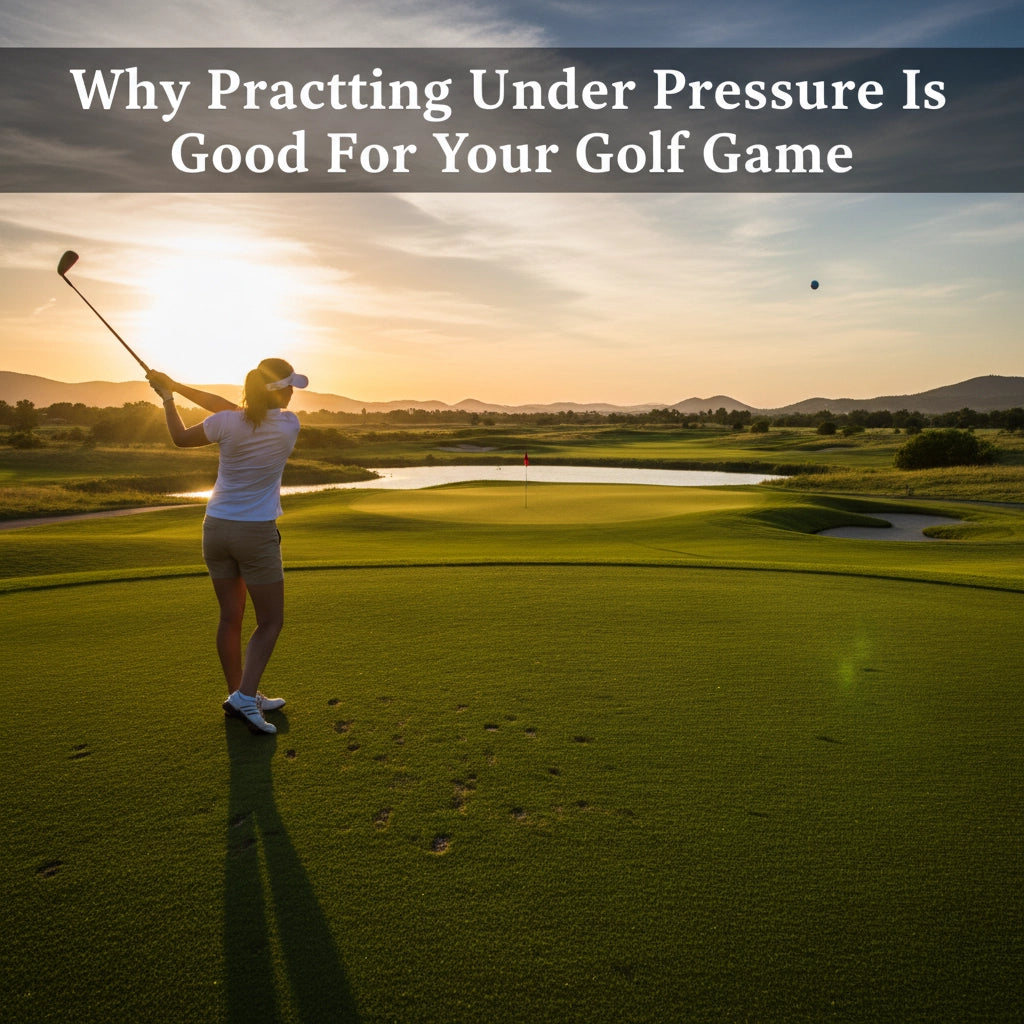
Why Practicing Under Pressure Is Good For Your Golf Game
Share
Have you ever wondered why your driving range performance doesn't translate to the golf course? You stripe ball after ball on the range, feeling confident about your swing, only to struggle when it matters most during your round. The answer lies in one crucial missing element: pressure.
Practicing under pressure transforms your golf game by preparing you for the mental and emotional challenges you face during actual play. When you practice without consequences, you're not truly preparing for the moments when every shot counts.
The Performance Gap: Range vs Real Play
Most golfers experience a significant performance drop between practice and competition. This gap exists because traditional practice fails to simulate the thoughts, feelings, and emotions you experience when your performance actually matters.
On the driving range, you have unlimited balls and a massive target area. A poor shot simply means reaching for another ball from your basket. But on the course, every shot has consequences. Your score depends on each swing, and there are no do-overs.
This disconnect explains why you might hit 7-irons perfectly on the range but struggle with the same club when standing over a crucial approach shot during your round. Your technical skills remain the same, but the mental pressure changes everything.
What Pressure Practice Actually Does
Pressure practice strategically increases stress during training to improve your ability to perform when stakes are high. This approach works by:
Building Mental Resilience When you repeatedly practice under pressure, you develop the ability to manage stress, frustration, and anxiety. You learn to maintain composure after poor shots and think clearly in challenging situations.
Creating Realistic Expectations Pressure practice helps you understand what competitive golf actually feels like. You experience the elevated heart rate, tight muscles, and racing thoughts that accompany important shots.
Developing Coping Strategies Through repeated exposure to pressure situations, you naturally develop techniques for managing stress and maintaining focus when it matters most.

Effective Pressure Practice Methods
Challenge Practice Create drills that add intensity to your practice sessions. Set specific goals with consequences for failure. For example, you must make five consecutive putts from three feet before ending your session. If you miss, start over.
Competition Drills Practice with friends and introduce stakes. The player with the worst score on a particular hole does push-ups or pays for drinks. Even small consequences make shots matter more.
Timed Exercises Set time limits for completing specific tasks. You have 30 seconds to set up and execute each shot, or you must make 10 putts in five minutes. Time pressure simulates the pace of play pressure you feel on the course.
Limited Shot Practice Restrict the number of balls you hit during practice. Instead of hitting 50 drives, hit only 10 and make each one count. Track your results and set improvement targets.
Heart Rate Training Do jumping jacks or run in place before hitting shots to elevate your heart rate. This simulates the physical stress you feel during important moments on the course.
Putting Under Pressure
Putting benefits enormously from pressure practice because short putts often determine your final score. Most recreational rounds include only a handful of truly meaningful putts, but these moments can make or break your round.
Create putting challenges that mirror course conditions. Set up different length putts and require yourself to make a certain percentage before moving on. Miss your target, and you start over.
Use alignment sticks or training aids to create gates that make your target smaller. This increases pressure and forces more precise execution.
Practice with distractions. Have someone talk while you putt, or practice in windy conditions. These challenges prepare you for the various disruptions you encounter during actual play.

Short Game Pressure Training
Your short game faces intense pressure because these shots often determine whether you save par or drop strokes. Practice chipping and pitching with specific targets and limited attempts.
Set up various lies around the practice green and give yourself only one attempt at each shot. This mirrors course conditions where you must execute from whatever lie you find.
Create scoring games for your short game practice. Award points for getting close to the pin and deduct points for poor shots. Track your scores over multiple sessions to monitor improvement.
Training Aids That Support Pressure Practice
Modern golf training aids can enhance your pressure practice by providing immediate feedback and creating specific challenges.
Alignment trainers help you set up consistently under pressure. When you're nervous, your setup often changes first. Training aids that promote proper alignment help maintain fundamentals when stress levels rise.
Putting trainers with gates or tracks force precision and create pressure through smaller targets. Missing the target provides immediate feedback and creates natural consequences.
Tempo trainers help maintain swing rhythm under pressure. When tension increases, swing tempo often becomes erratic. Training aids that promote consistent tempo help combat this common pressure response.
The Mental Game Benefits
Pressure practice develops crucial mental skills that extend beyond golf technique. You learn to manage frustration when shots don't go as planned and maintain confidence after setbacks.
Regular pressure practice teaches you to embrace challenging situations rather than avoid them. You begin to view pressure as an opportunity to test your skills rather than a threat to your performance.
This mental shift transforms your approach to competitive situations. Instead of hoping to avoid pressure, you actively seek it out because you've trained to handle it effectively.

Creating Your Pressure Practice Routine
Start with small amounts of pressure and gradually increase intensity as you become more comfortable. Begin with simple challenges like making three consecutive three-foot putts.
Establish clear goals for each pressure practice session. Know exactly what you want to accomplish and how you'll measure success. This creates focus and purpose in your practice.
Track your results over time. Keep records of your performance in pressure situations so you can monitor improvement and identify areas needing more work.
Vary your pressure practice methods to prevent adaptation. Use different types of consequences, time limits, and challenges to keep your practice engaging and effective.
Integration with Regular Practice
Pressure practice shouldn't replace all your regular practice, but it should become a significant component. Dedicate at least 25% of your practice time to pressure situations.
Use pressure practice to test skills you've developed during technical practice. If you've been working on your swing mechanics, create pressure situations to see if the changes hold up under stress.
End each practice session with some form of pressure drill. This ensures you finish with competitive-like conditions and helps transfer your practice gains to actual play.
Long-Term Development
Consistent pressure practice builds confidence that extends to all areas of your game. When you've succeeded repeatedly in pressure situations during practice, you approach competitive moments with greater belief in your abilities.
Over time, what once felt like high pressure becomes your normal operating environment. Situations that previously caused anxiety become routine because you've experienced similar challenges countless times in practice.
This gradual adaptation allows you to perform closer to your practice level during actual rounds. The gap between your range performance and course performance narrows as you become comfortable with pressure.
Pressure practice represents one of the most effective ways to improve your competitive golf performance. By systematically exposing yourself to challenging situations during practice, you develop the mental resilience and practical skills needed to perform when it matters most.

